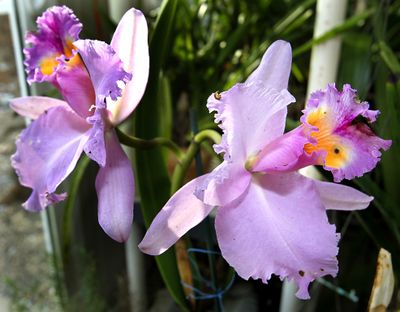Making a case for orchids
Fans insist costs, demands are often overstated

AKRON, Ohio – In the houseplant world, orchids have gotten a bad rap.
Many people shy away from growing them, figuring they’re too exotic, too demanding, too expensive.
Orchid lovers Cynthia Druckenbrod and Mary Bell have a message for those horticultural scaredy cats: Get over it.
Growing orchids successfully is a matter of finding the right plant for your conditions, said Bell, who grows around 500 orchids in the greenhouse attached to her Coventry Township, Ohio, home. Not all orchids are easy to grow, but there are plenty of choices that are, she said.
And many of those orchids have become so affordable that you don’t have to make a long-term commitment, she said. If you don’t want to spend the time and effort coaxing one to rebloom, don’t bother. Just replace it.
“You really haven’t lost that much,” she said.
Even with hundreds of plants to care for, Bell said she tends to her orchids only once or twice a week, whenever she needs to relax. She adds fungicide and a weak dose of fertilizer whenever she waters, treats for insects when she needs to and repots every couple of years, or sometimes sooner. But otherwise her orchids are fairly fuss-free.
She doesn’t even worry when she knocks a potted orchid over. She just looks at that as repotting.
Bell, who started with five orchids in the late 1970s and has been growing them in earnest for about 15 years, said she used to think of them as delicate. Then she visited Brazil and saw how some of the exotic types grow in nature, often in what seemed to be inhospitable conditions.
“I really relaxed. … Nature does not put things in pots,” she said.
Bell’s orchids grow in a variety of conditions that mimic their natural preferences – some in hanging baskets high in the greenhouse, some under grow lights, still others clinging to pieces of tree bark, without even any growing medium. They stay in the greenhouse in winter and go outdoors in warmer weather to a lath house in her backyard.
Orchids grow naturally in most parts of the world. But the fetching types most people prize are natives of warmer climates and need to stay indoors in the North in winter, Bell said.
Her favorite orchids are showy vandas and cattleyas, but a better choice for beginners is the moth orchid, said Druckenbrod, an orchid enthusiast and the director of horticulture and conservation at Cleveland Botanical Garden.
Moth orchids, properly called phalaenopsis orchids, are easy to grow indoors and bloom for a long time. They thrive outside in warmer weather, provided they’re kept in a covered area where they’re protected from the rain. If water gets to a moth orchid’s crown, the plant can rot, Bell said.
Moth orchids are also accessible, Druckenbrod noted.
“I think what’s breaking down the barriers is they’re readily available now,” she said. Breeders have developed methods for growing moth orchids in mass quantities, so the plants are found even in grocery and home improvement stores at prices that often hover around $15.
And best of all, they’re beautiful. Their long flower spikes and flat, elliptical flowers give them a graceful, glamorous appearance that belies their low-fuss nature.
Put a moth orchid in indirect light and never in direct sun, Druckenbrod advised. The orchids like humidity, so let them spend some time in a bathroom now and then.
(Got a bathroom window that gets indirect light? You have the perfect environment for a moth orchid.)
Go easy on watering, Druckenbrod advised. Moth orchids are epiphytes, she said, which means they grow in nature on other plants and don’t need or want a great deal of water.
In fact, Bell suggests thinking of orchids more like cut flowers than long-term houseplants. Get an inexpensive one you like, and “if it’s done (flowering), it’s done,” she said. Buy a new one.
“People don’t have to be afraid,” she said.